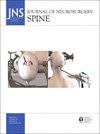Necessity of posterior osteotomies for mild flexible cervical deformity correction.
IF 2.9
2区 医学
Q2 CLINICAL NEUROLOGY
引用次数: 0
Abstract
OBJECTIVE Correction of mild flexible cervical deformity (CD) via the posterior approach has been described with and without the use of posterior osteotomies (POs), despite a lack of clarity regarding their necessity or risks. The purpose of this study was to determine whether the use of POs when correcting mild flexible CD leads to improved clinical or radiographic outcomes, as well as defining the relative risks in utilizing them. METHODS A prospective multicenter registry of operative CD patients was analyzed. Inclusion criteria were cervical kyphosis > 10°, cervical scoliosis > 10°, cervical sagittal vertical axis (cSVA) > 4 cm, or chin-brow vertical angle > 25°. Mild deformity was defined by a cSVA of 3-5 cm and/or kyphosis < 15°. Flexibility was defined by a C2-7 angular change > 5° on preoperative flexion/extension radiographs. Patients who received a posterior column osteotomy (PCO) (Ames grades 1 and 2) were compared with patients who did not undergo a PCO (noPCO) as well as those who underwent a three-column osteotomy (3CO) (Ames grades 3-6). RESULTS Ninety-five patients (33 PCO, 49 noPCO, 13 3CO) met the inclusion criteria. Both the number of levels fused (9.2 vs 7.7, p = 0.001) and the estimated blood loss (EBL) (1027 vs 486 mL, p = 0.012) were higher in the PCO cohort. Patients in the noPCO group were more likely to have a cervical apex of kyphosis (71.1%, p = 0.046), while those undergoing 3COs were more likely to have a thoracic apex (58.3%, p = 0.005). Preoperative cSVA (PCO vs noPCO: 45.4 vs 37.9 cm, p = 0.084), T1 slope (32.5° vs 29.6°, p = 0.376), C2-7 lordosis (-8.9° vs -9.2°, p = 0.942), and modified Japanese Orthopaedic Association (mJOA) score (13.4 vs 13.5, p = 0.854) were similar; however, both Neck Disability Index (NDI) (55.6 vs 42, p = 0.002) and numeric rating scale (NRS) neck (7.2 vs 5.8, p = 0.028) scores were higher in the PCO group before surgery. When adjusting for the use of an anterior approach, there was no significant difference in 1-year postoperative cSVA (35.7 and 35.6 cm, respectively; p = 0.969), C2-7 lordosis (13.7° and 10.1°, respectively; p = 0.393), and patient-reported outcome measures (NRS, NDI, and mJOA) between the PCO and noPCO groups. Two-year radiographic outcomes were largely similar, except for C2 slope, which was higher in the PCO group (29.1° vs 18°, p = 0.026). The overall complication rates progressively increased with more complex osteotomy use (noPCO 68.8% vs PCO 71.9% vs 3CO 75%) but did not reach significance (p = 0.063). CONCLUSIONS The use of POs for mild flexible adult CD may not be necessary to achieve desirable radiographic correction. They are associated with greater EBL and fusion burden. Further studies are needed to fully delineate the risks of adverse events for various types of osteotomies.轻度柔性颈椎畸形矫正后截骨术的必要性
目的通过后路方法矫正轻度柔性颈椎畸形(CD)时,尽管后路截骨术(POs)的必要性和风险尚不明确,但已有使用和不使用后路截骨术(POs)的描述。本研究旨在确定在矫正轻度柔性 CD 时使用后路截骨术是否会改善临床或影像学结果,并确定使用后路截骨术的相对风险。纳入标准为颈椎后凸 > 10°、颈椎侧弯 > 10°、颈椎矢状垂直轴 (cSVA) > 4 厘米或颏眉垂直角 > 25°。轻度畸形的定义是 cSVA 为 3-5 厘米和/或脊柱侧弯 < 15°。术前屈曲/伸展X光片显示C2-7角度变化大于5°,即为灵活度。将接受后柱截骨术(PCO)(艾姆斯1级和2级)的患者与未接受PCO(noPCO)的患者以及接受三柱截骨术(3CO)(艾姆斯3-6级)的患者进行比较。PCO 组患者的融合层次数(9.2 对 7.7,p = 0.001)和估计失血量(EBL)(1027 对 486 毫升,p = 0.012)均较高。无PCO组患者更有可能出现颈椎顶点后凸的情况(71.1%,p = 0.046),而接受3CO的患者更有可能出现胸椎顶点后凸的情况(58.3%,p = 0.005)。术前cSVA(PCO vs noPCO:45.4 vs 37.9 cm,p = 0.084)、T1斜度(32.5° vs 29.6°,p = 0.376)、C2-7前凸(-8.9° vs -9.2°,p = 0.942)和改良日本骨科协会(mJOA)评分(13.4 vs 13.5,p = 0.854)相似;但术前,PCO 组的颈部残疾指数(NDI)(55.6 vs 42,p = 0.002)和颈部数字评分量表(NRS)(7.2 vs 5.8,p = 0.028)评分均较高。如果对使用前路方法进行调整,PCO 组和无 PCO 组之间在术后 1 年的 cSVA(分别为 35.7 厘米和 35.6 厘米;p = 0.969)、C2-7 椎体前凸(分别为 13.7°和 10.1°;p = 0.393)以及患者报告的结果指标(NRS、NDI 和 mJOA)方面没有显著差异。两年的放射学结果大体相似,但 C2 坡度除外,PCO 组的 C2 坡度更高(29.1° vs 18°,p = 0.026)。总体并发症发生率随着截骨术的复杂程度增加而逐渐上升(无 PCO 68.8% vs PCO 71.9% vs 3CO 75%),但未达到显著性水平(p = 0.063)。结论:对于轻度柔性成人 CD,可能并不需要使用 POs 来达到理想的放射学矫正效果。需要进一步的研究来全面界定各种类型截骨术的不良事件风险。
本文章由计算机程序翻译,如有差异,请以英文原文为准。
求助全文
约1分钟内获得全文
求助全文
来源期刊

Journal of neurosurgery. Spine
医学-临床神经学
CiteScore
5.10
自引率
10.70%
发文量
396
审稿时长
6 months
期刊介绍:
Primarily publish original works in neurosurgery but also include studies in clinical neurophysiology, organic neurology, ophthalmology, radiology, pathology, and molecular biology.
 求助内容:
求助内容: 应助结果提醒方式:
应助结果提醒方式:


